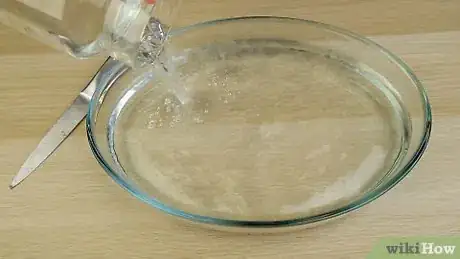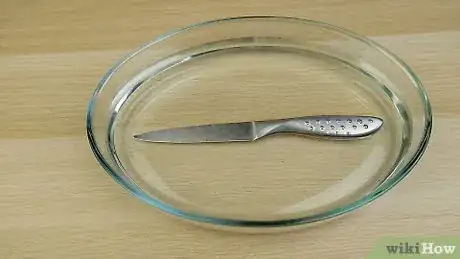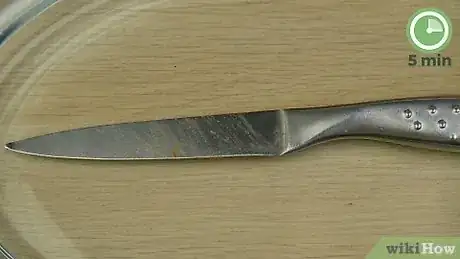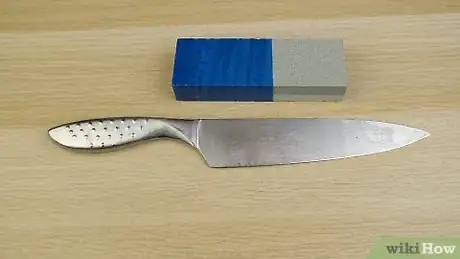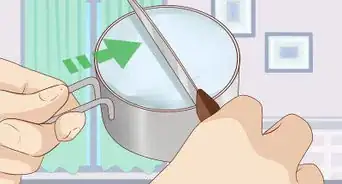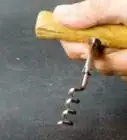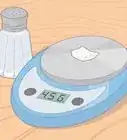This article was co-authored by wikiHow staff writer, Jessica Gibson. Jessica Gibson is a Writer and Editor who's been with wikiHow since 2014. After completing a year of art studies at the Emily Carr University in Vancouver, she graduated from Columbia College with a BA in History. Jessica also completed an MA in History from The University of Oregon in 2013.
There are 12 references cited in this article, which can be found at the bottom of the page.
The wikiHow Culinary Team also followed the article's instructions and verified that they work.
This article has been viewed 19,748 times.
Learn more...
It's aggravating to pull out your knife to find rust on the blade, but don't throw it out! You can clean rust from the knife using things you already have around the house. Most cleaning methods rely on acids like vinegar and lemon, which react to dissolve the rust. If your knife doesn't have much rust or you want an easy cleaning method, soak the blade in vinegar or scrub it with lemon and salt. To clean pocket knives or a heavily rusted blade, rub a rust eraser over the surface.
Steps
Soaking the Blade in Vinegar
-
1Fill a tall container with white vinegar. Set a sturdy container on your work surface. Choose a container that's as tall as your blade is long so you'll be able to submerge it completely. Pour in enough white vinegar until it reaches 1 inch (2.5 cm) from the top of the container.[1]
- If you can't find a container that's tall enough, find a shallow container that you can lay your knife in instead.
- If you're removing rust from several knives, you can use just 1 container for them as long as all the knives fit.
-
2Submerge the blade in the vinegar. Take your rusty knife and put it blade down into the container. Ensure that the rusty part is completely in the vinegar so the vinegar can loosen the rust. For example, if the area where the blade meets the handle is rusty, you might need to pour in a little more vinegar so this part is submerged.[2]
- If you're laying the knife flat in a container, keep in mind that the handle will get wet. This is fine if the handle is made of plastic or metal, but moisture can warp wooden handles over time.
Advertisement -
3Soak for the knife for 5 minutes. Set a timer to give the vinegar a chance to strip the rust from the knife blade. If you're soaking a knife with a wooden handle, it's important not to soak it for longer than this or your handle could crack.[3]
- The vinegar smell is strong, so you might want to open a window for ventilation while you soak the knife.
-
4Scrub the blade with a sponge or toothbrush. Remove the knife from the vinegar and take it over to your sink. Carefully rub a sponge or old toothbrush over the area that had been rusty. If you still see stubborn rust spots that don't come away, sprinkle little baking soda on the blade and scrub it again with a damp sponge or toothbrush.[4]
- For really tough rust spots, take a piece of steel wool and rub it back and forth over the blade.
-
5Rinse the old knife and dry it completely. Run cold water over the blade and the handle to remove the rust particles. Then, carefully wipe both sides of the blade with a soft, dry cloth to remove all moisture.[5]
- To prevent the knife from rusting again, it's critical to keep the blade dry.
Scrubbing with Lemons and Salt
-
1Cut a lemon in half and rub it on the rusty blade. Set a lemon on a cutting board and slice across it to make 2 halves. Take the cut-side of 1 half and carefully rub it back and forth on 1 side of the knife blade. Turn over the knife and repeat this on the other side of the blade if it's rusty too.[6]
-
2Scrub the knife with a sponge to loosen the rust. Once you've rubbed the lemon on the blade, set the lemon half aside and get a sponge damp. Apply pressure as you carefully rub the sponge back and forth over the knife blade.[7]
- If you're using a rectangular sponge, try folding it in half over the dull edge of the knife blade. Pinch the sides of the sponge as you slide it up and down the blade.
-
3Dip a lemon half in salt and use it to scrub the blade. Pour salt into a small dish and dip a lemon half into it so the salt sticks to the cut side. Then, scrub the rusty areas of the blade until the salt dissolves.[8]
- Use any type of salt you have like table salt or kosher salt.
- The salt is abrasive so it can remove rust from the surface of the knife blade.
-
4Wash the knife with soapy water. Take the knife to your sink and run cold water over it to rinse off the lemon juice and salt. Then, use a soapy washcloth to carefully wipe the blade clean before you rinse it with cold water again.[9]
- Be very careful with you're washing a slippery knife. Try to keep the handle free from soap so you can grip it firmly while you wash the blade.
-
5Rinse the knife and dry it with a soft cloth. Run cold water over the blade to rinse off rust particles and soap. Pat the clean blade dry with a soft cloth that won't scratch it and store the knife away from moisture.[10]
- To further protect your knife from rusting, lightly coat it with vegetable oil if it's a cooking knife or machine oil if it's a pocket or hunting knife.
Using a Rust Eraser Tool
-
1Buy a rust eraser made of grinding compounds and plastic. Check your local hardware store, kitchen supply store, or online for a rust eraser. This small square or rectangular eraser is stretchy like a standard eraser, but it has gritty materials like silicon carbide that grind down the rust on metal.[11]
- Rust erasers come in different grits, so choose one according to how much rust is on your knife. For example, if there are just a few rust spots, get a fine-grit eraser or choose a medium-grit one for a rustier knife.
-
2Rub the eraser back and forth across the knife blade. Look at the surface of the knife to see the fine metal lines that make the grain of the blade. Set the eraser on a rusty area and rub back in forth in the same direction as those lines. Rub the eraser on the blade for 5 to 10 minutes, depending on how rusty your knife is. Repeat this for the other side of the knife if it's rusty.[12]
- The grain is formed when the metal is heated and rolled to make the blade.
- Apply firm pressure as you erase so you remove a deeper layer of rust.
-
3Wipe the knife with a soft cloth. This gets rid of rust particles, bits of the eraser, and dirt that was on the knife. Then, check the blade for any signs of rust. If you still see rust spots, rub the eraser on them for a few more minutes before you wipe the knife again.
-
4Rub oil on both sides of the knife blade to protect it from rusting. Once you've cleaned the knife, protect it from moisture. Squeeze a drop of vegetable or cooking oil on 1 side of the blade and wipe it across the surface with a clean cloth. Then, spread another drop of oil on the other side of the knife. If you're working with a hunting or pocket knife, use knife oil or lubricant.[13]
- If you have a folding pocket or hunting knife, knife oil or lubricant keeps the folding mechanism greased so it doesn't rust shut. You can buy knife or lubricant in most hunting and outdoor stores.
Warnings
- Always use caution when you're handling and cleaning knives.⧼thumbs_response⧽
- Avoid using products that aren't non-toxic or food-safe to clean your blades.[17]⧼thumbs_response⧽
Things You'll Need
Soaking the Blade in Vinegar
- Container
- White vinegar
- Rusty knife
- Sponge or toothbrush
- Soft cloth
Scrubbing with Lemons and Salt
- Rusty knife
- Cutting board
- Wash cloth
- Dish soap
- Sponge
- Soft cloth
Using a Rust Eraser Tool
- Rust eraser
- Rusty knife
- Soft cloth
- Oil
References
- ↑ https://youtu.be/H0ZD4l4xBgc?t=18
- ↑ https://www.cnet.com/how-to/remove-rust-stains-from-kitchen-knives-with-vinegar/
- ↑ https://www.cnet.com/how-to/remove-rust-stains-from-kitchen-knives-with-vinegar/
- ↑ https://ucanr.edu/blogs/blogcore/postdetail.cfm?postnum=28798
- ↑ https://www.cnet.com/how-to/remove-rust-stains-from-kitchen-knives-with-vinegar/
- ↑ https://youtu.be/C7NkJHlQMlA?t=15
- ↑ https://www.thekitchn.com/heres-how-to-save-rusty-knives-243778#comments-243778
- ↑ https://youtu.be/C7NkJHlQMlA?t=41
- ↑ https://www.thekitchn.com/heres-how-to-save-rusty-knives-243778#comments-243778
- ↑ https://www.thekitchn.com/heres-how-to-save-rusty-knives-243778#comments-243778
- ↑ https://www.cooksillustrated.com/equipment_reviews/1585-rust-erasers-for-carbon-steel-knives
- ↑ https://youtu.be/SwRsKeS6pwU?t=134
- ↑ https://youtu.be/c_3TrVbQxVY?t=92
- ↑ https://www.cooksinfo.com/ceramic-knives
- ↑ https://www.thekitchn.com/5-essentials-in-caring-for-a-chefs-knife-234769
- ↑ https://www.thekitchn.com/5-essentials-in-caring-for-a-chefs-knife-234769
- ↑ https://www.thekitchn.com/heres-how-to-save-rusty-knives-243778
